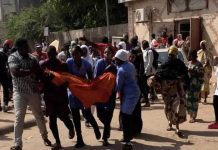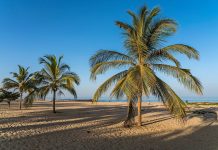Ms. Guillaud said this at the inauguration ceremony of the EU funded Sofanyama Bridge on 30 November 2014. The EU Chargee d’Affaires gave a breakdown of what the 76.5 million euros had financed in terms of the rehabilitation and construction of roads with 48.5 million euros coming from the 9th EDF, 40.5 million euros from the Gambian National Indicative Programme, three million euros from the Senegalese National Indicative Programme to cover the trunk road from Sabi to Velingara, and five million euros from the ECOWAS Regional Indicative Programme as part of the regional integration of Western Africa. The remaining 28 million euros, she added, were financed under the 10th EDF Gambia National Indicative Programme. Ms. Guillaud identified the roads financed by the EU as the Barra-Amdallai Road (19.9 km), the Madina Ba-Seleti Road (12.7 km), the Trans-Gambia Highway (25 km), and the Soma-Basse road (193 km) which includes the Sofanyama Bridge. “The European Union has also contributed as much as 7 million euros to the Basse-Velingara road project, which will be completed in the near future,” disclosed the EU Chargee d’Affaires. She commended the 28 member states of the EU as well as the European tax payers for making this possible with their important contribution for the improvement of the road network in The Gambia. She noted that the “Support to The Gambia’s National Transport Plan” is considered one of the most important projects in the cooperation between The Gambia and the EU. Highlighting the need for regular and effective maintenance of the road infrastructure, the EU Chargee d’Affaires noted that more predictability for the medium-term road maintenance budget is necessary to cover a well-established maintenance programme. “We are pleased to see that the budget allocated to the Road Fund has increased year after year, and has reached as much as 73 million GMD in 2013,” she noted. She also underlined the necessity of weighing stations for axle load control in order to limit the weight of trucks crossing the country as part of the control mechanisms being recommended by ECOWAS. “The trunk roads Barra-Amdallai and Mandina Ba-Seleti, Trans-Gambia Highway and the Soma-Basse-Velingara will be used by an increasing number of trucks from Senegal, Guinea Bissau, Guinea Conakry, and other sister countries. Therefore, it is of paramount importance to control this parameter to maintain the roads. The European Union would welcome a dialogue on how to finance these stations in the context of our 11th EDF financial envelope,” concluded the EU Chargee d’Affaires. In his inauguration statement, the Minister of Transport, Works and Infrastructure, Mr. Ousman Badgie, who deputized the president of the republic, highlighted the importance that the government attaches to the development of the infrastructure in this country. He acknowledged the support being provided by the EU for the rehabilitation and construction of roads in the country. The Transport, Works and Infrastructure Minister commended the EU for the support. The Sofanyama Bridge along the Soma-Basse road, which divides Jarra East in the Lower River Region (LRR) and Niamina West in Central River Region –South (CRR), provides access to the Eastern part of the country. ]]>
© 2019 Foroyaa Newspaper - Site by DigiTech Solutions



















